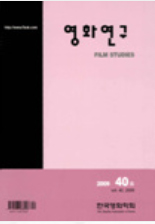- 영문명
- A Certain Aesthetical Experiment in the Rotoscoping Animation
- 발행기관
- 한국영화학회
- 저자명
- 김병철
- 간행물 정보
- 『영화연구』제40호, 7~36쪽, 전체 30쪽
- 주제분류
- 예술체육 > 예술일반
- 파일형태
- 발행일자
- 2009.06.30

국문 초록
영문 초록
Rotoscoping is an animation technique in which animators trace over live-action film movement, frame by frame, for use in animated films. In the early years of film history, it was used in the cell animation. Nowadays digital technology has used rotoscoping technique again. I think rotoscoping animation made digital technology provoke some issues about digital cinema and image in the age of digital technology. So I use Richard Linklater's (2000), (2006), Ikhwan Choi's (2008) for instance of rotoscoping animation. Process of making a rotoscoping animation starts from the shooting an action by camera. After that the computer captures the image from the footage and trace over the contour. In this process the objects in the real world disappear and the new kind of images come out. The indexicality which connects between the real world and image has weakened. And rotoscoped images look like a images of paintings. So, in spite of being shot by camera ruled by linear perspective, rotoscoped images look flat. The flatness of image show the nature of the digital image which take the no space in the real world. The flatness of images means that media like rotoscoping animation has the opacity. The media doesn't show the real directly to the spectator. Instead it show the form which reflects the media itself. The appearance of the new kind of technology awakes the revival of the old. So we should judge the value of the new technology in the media by how to use. It would be progressive or retrospective. Images of rotoscoping animation are the touchstones of the new media and the images in the digital cinema.
목차
1. 들어가는 말
2. 로토스코핑 이미지가 제기하는 쟁점들
3. 결론
해당간행물 수록 논문
참고문헌
최근 이용한 논문
교보eBook 첫 방문을 환영 합니다!

신규가입 혜택 지급이 완료 되었습니다.
바로 사용 가능한 교보e캐시 1,000원 (유효기간 7일)
지금 바로 교보eBook의 다양한 콘텐츠를 이용해 보세요!


